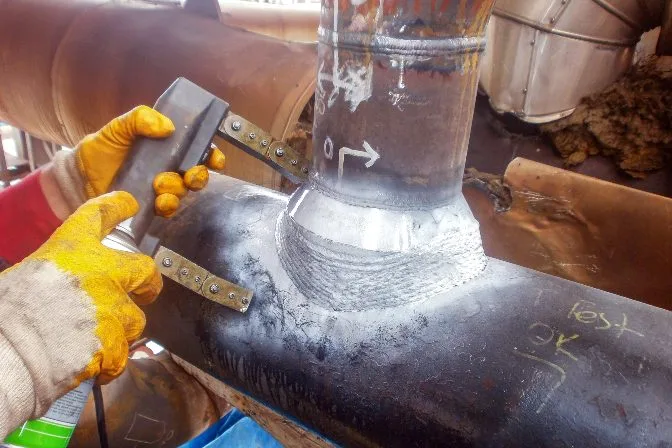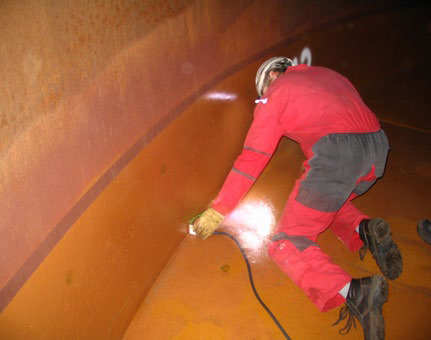The Value of Professional Tank Welding Inspection Solutions
The Value of Professional Tank Welding Inspection Solutions
Blog Article
A Comprehensive Introduction of Storage Tank Welding Examination Specifications and Methodologies for Improved Weld High Quality and Efficiency
The significance of welding examination requirements in the production of tanks can not be overstated, as they function as the foundation for guaranteeing weld stability and operational dependability. Numerous inspection strategies, including visual evaluations and advanced non-destructive testing techniques, are essential in identifying potential imperfections that might compromise performance. Furthermore, adhering to governing standards not just improves weld high quality but also minimizes the threat of costly failures. As we discover the nuances of these techniques, it comes to be important to think about exactly how a methodical approach can transform current techniques and lead to significant improvements in results.
Significance of Welding Inspection Criteria

Welding assessment criteria include a range of requirements, consisting of material specifications, welding procedures, and qualifications of employees entailed in the welding procedure. By enforcing these criteria, organizations can methodically determine and fix possible defects, thus minimizing the chance of expensive repair services or disastrous failures. Rigorous evaluation methods cultivate a society of liability and precision, urging welders to maintain high levels of craftsmanship.

Typical Welding Inspection Strategies


Ultrasonic Evaluating (UT) is one more common strategy, making use of high-frequency acoustic waves to discover internal imperfections that might not be visible externally. This approach is especially efficient for recognizing gaps or additions within the weld steel. Magnetic Bit Checking (MT) is additionally extensively used, especially for ferromagnetic products, as it reveals surface and near-surface flaws via the application of electromagnetic fields and ferrous bits.
In Addition, Fluid Penetrant Testing (PT) detects surface-breaking problems by applying a penetrant to the weld and after that utilizing a developer to extract the penetrant. Each of these strategies adds to a comprehensive evaluation method, ensuring that welds fulfill the stringent quality criteria needed in tank building.
Governing Criteria and Compliance
Governing criteria and conformity are essential parts in making certain the security and dependability of welded structures in storage tank building - Tank Welding Inspection. These standards offer to establish minimum demands for material homes, welding procedures, and examination methods, consequently lowering the threat of architectural failings and enhancing general efficiency
Secret companies, such as the American Culture of Mechanical Engineers (ASME) and the American Welding Society (AWS), supply guidelines that are widely adopted in the market. Conformity with these criteria not only ensures adherence to finest techniques however additionally satisfies lawful and contractual commitments, securing the passions of stakeholders.
Governing bodies typically mandate adherence to certain codes, such as ASME Code Section IX for best site welding qualifications and API 650 for bonded storage tanks. These codes detail demands for welding techniques, certifications of employees, and screening methods to verify weld integrity.
Regular audits and examinations are essential to preserving conformity, as they help determine deviations from established requirements. Non-compliance can result in significant charges, project delays, and safety dangers. Thus, a durable understanding of regulatory criteria and a commitment to compliance are paramount in accomplishing top quality and sturdy welded tank frameworks.
Non-Destructive Evaluating Approaches
Just how can the stability of bonded structures be assured without creating damage? Non-destructive testing (NDT) techniques supply a durable service, making it possible for assessors to review weld top quality without jeopardizing the product - Tank Welding Inspection. Among one of the most common NDT techniques are ultrasonic testing (UT), her comment is here radiographic screening (RT), magnetic particle screening (MT), and color penetrant testing (PT)
Ultrasonic testing employs high-frequency audio waves to find interior defects and characterize product residential properties. It gives specific dimensions and is especially reliable for thick materials. Radiographic screening involves passing X-rays or gamma rays with the weld, creating images that expose architectural problems such as fractures or gaps. This method is indispensable for examining the integrity of intricate welds.
Magnetic particle testing is suited for ferromagnetic products, where electromagnetic fields expose surface area and near-surface stoppages. Dye penetrant screening makes use of a liquid dye to highlight surface-breaking defects, making it a reliable approach for non-porous products.
Each of these NDT techniques has distinctive advantages, enabling for detailed analyses customized to certain products and welding processes. By applying these techniques, sectors can ensure the integrity and safety of welded frameworks, ultimately boosting overall efficiency.
Enhancing Weld High Quality Through Evaluation
Reliable examination plays an important role in boosting weld high quality, serving as an important checkpoint in the construction process. By determining prospective issues early, evaluations reduce the risk of compromised structural integrity and make certain compliance with sector criteria. Employing a mix of visual examinations, non-destructive screening (NDT) methods, and mechanical assessments, examiners can detect issues such as porosity, splits, and incomplete combination.
Executing a durable inspection protocol not just boosts the overall high quality of welds yet likewise cultivates a culture of liability amongst welders and makers. Normal training and certification of evaluation employees ensure that they are furnished with the needed abilities to acknowledge and deal with prospective issues efficiently. This aggressive strategy decreases rework and linked expenses, inevitably adding to predict performance.
In addition, detailed paperwork of examination findings provides beneficial understandings right into recurring issues, helping with continuous improvement in welding methods. By leveraging innovative technologies, such as automated ultrasonic screening or digital radiography, weld top quality can be enhanced via much more accurate examinations. Finally, a rigorous inspection process is crucial in attaining top quality welds, ensuring safety, dependability, and longevity in container construction.
Final Thought
Finally, the application of strenuous container welding assessment criteria and techniques is necessary for guaranteeing weld stability and efficiency. By using a combination of aesthetic examinations, non-destructive testing methods, and adherence to regulatory requirements, companies can effectively try this site determine and mitigate potential issues. Cultivating a culture of responsibility among welders additionally enhances the high quality of welding processes. Ultimately, these techniques add to decreased architectural failures, reduced repair expenses, and enhanced functional effectiveness within the market.
Report this page